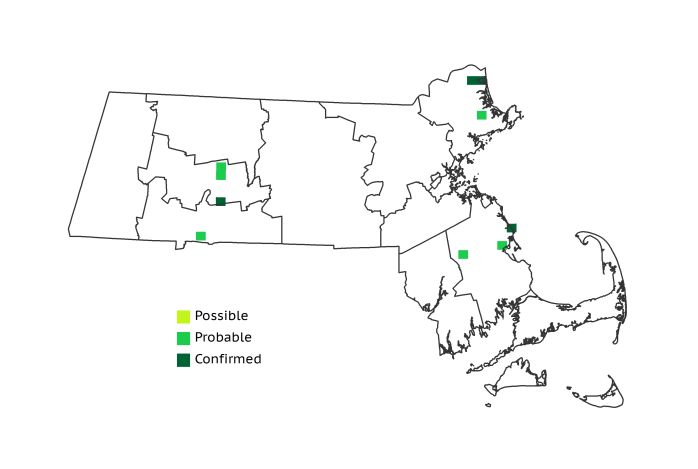Find a Bird
Upland Sandpiper
Bartramia longicauda

Very local and strongly declining
Conservation action urgent
Endangered Species
“Of all the passers-through, the species that means the most to me, even more than geese and cranes, is the upland plover…. I know their presence through the mournful yet eager quavering whistles… and it makes me think of when the American plains were virgin and their plover came through in millions.” – John Graves, Self-Portrait With Birds
The genus Bartramia is monotypic, containing a single, unique species: the Upland Sandpiper. Upland Sandpipers are country birds, hunting insects by sight in fields of short grass. Although the bulk of their U.S. distribution falls in the prairies of the Upper Midwest, the ethereal piping of Upland Sandpipers has long been heard in the hayfields and meadows of Massachusetts. Today, these “grasspipers” are an endangered species in our Commonwealth and persist only at a few select locations.
Historic Status
The “Upland Plover,” as it once was known, is something of a shorebird anomaly, a species that avoids the shore and breeds in large patches of open grassland. At one time, the farm-dominated Massachusetts landscape provided an ample amount of such habitat. Though thriving in the middle of the nineteenth century, Upland Sandpipers were no match for the market gunners who sought them for the reasons described by Forbush (1925): “Harmless and eminently useful, it nevertheless is one of the most luscious morsels to delight the epicurean palate.” Hunted nearly to extirpation, the remaining Upland Sandpipers in Massachusetts tried to seek refuge in the gradually dwindling grasslands of the state as they transitioned from agrarian to urban, suburban, and industrial usage throughout the twentieth century.
Atlas 1 Distribution
Long after their former heyday in pastoral Massachusetts, Upland Sandpipers were already rare breeders in the Commonwealth by the time of Atlas 1. Their need for extensive open grasslands severely limited them, and only the largest active pasturages and airfields in the state were suitable for breeding. Accordingly, 40% of all blocks in the state supporting Upland Sandpipers were located in the Connecticut River Valley, where large areas of open farmland could still be found, and also where the large airfield at Westover Air Force Base was located. In the Coastal Plains, only 5 occupied blocks were scattered among coastal sites where suitable grassy meadows could still be found. A Probable inland block in the Bristol/Narragansett Lowlands was the only other breeding evidence found in Atlas 1.
Atlas 2 Distribution and Change
This shorebird, which was already rare and local by the time of Atlas 1, is becoming even more so now. Although the Upland Sandpiper is a listed species in the state, its numbers continue to decline, and the species is increasingly becoming restricted to managed airfields. The small remnant population still existing in the Commonwealth is following the same trend as the species’ continental population (McGowan & Corwin 2008). Without stabilization of the declining continental population, or at least stabilization on a regional scale, persistence of this species in Massachusetts appears to be tenuous at best.
Atlas 1 Map

Atlas 2 Map

Atlas Change Map

Ecoregion Data
Atlas 1 | Atlas 2 | Change | ||||||
Ecoregion | # Blocks | % Blocks | % of Range | # Blocks | % Blocks | % of Range | Change in # Blocks | Change in % Blocks |
Taconic Mountains | 0 | 0.0 | 0.0 | 0 | 0.0 | 0.0 | 0 | 0.0 |
Marble Valleys/Housatonic Valley | 0 | 0.0 | 0.0 | 0 | 0.0 | 0.0 | 0 | 0.0 |
Berkshire Highlands | 0 | 0.0 | 0.0 | 0 | 0.0 | 0.0 | 0 | 0.0 |
Lower Berkshire Hills | 0 | 0.0 | 0.0 | 0 | 0.0 | 0.0 | 0 | 0.0 |
Vermont Piedmont | 0 | 0.0 | 0.0 | 0 | 0.0 | 0.0 | 0 | 0.0 |
Berkshire Transition | 0 | 0.0 | 0.0 | 0 | 0.0 | 0.0 | 0 | 0.0 |
Connecticut River Valley | 4 | 7.1 | 40.0 | 3 | 4.6 | 27.3 | -2 | -4.2 |
Worcester Plateau | 0 | 0.0 | 0.0 | 0 | 0.0 | 0.0 | 0 | 0.0 |
Lower Worcester Plateau | 0 | 0.0 | 0.0 | 0 | 0.0 | 0.0 | 0 | 0.0 |
S. New England Coastal Plains and Hills | 5 | 1.9 | 50.0 | 3 | 1.1 | 27.3 | -3 | -1.3 |
Boston Basin | 0 | 0.0 | 0.0 | 2 | 3.6 | 18.2 | 1 | 1.8 |
Bristol and Narragansett Lowlands | 1 | 0.9 | 10.0 | 0 | 0.0 | 0.0 | -1 | -1.0 |
Cape Cod and Islands | 0 | 0.0 | 0.0 | 3 | 2.1 | 27.3 | 2 | 1.7 |
Statewide Total | 10 | 1.0 | 100.0 | 11 | 1.1 | 100.0 | -3 | -0.4 |
Notes
The Upland Sandpiper shows a significant decreasing Breeding Bird Survey trend in the Eastern US overall.



